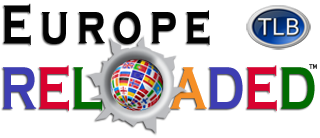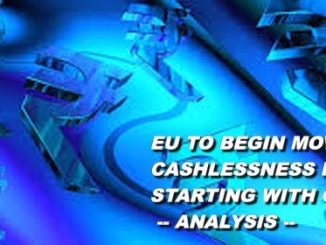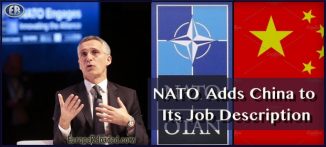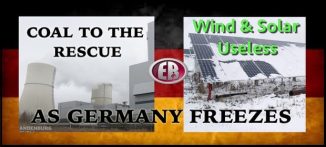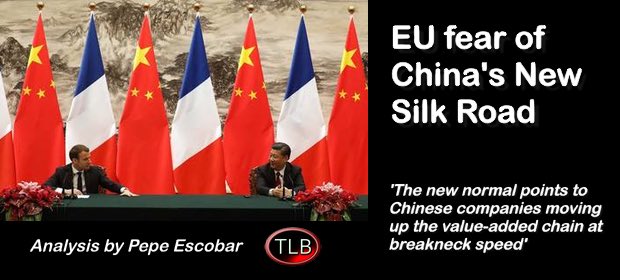
Why Europe Is Afraid of the New Silk Roads
Many EU countries are concerned about one-way traffic along the new trade routes Beijing is trying to set up to Europe
PEPE ESCOBAR
It came out as a sort of minor scandal – considering the ’24/7 post-truth news cycle.’ Of the 28 EU ambassadors in Beijing, 27, with the exception of Hungary’s, signed an internal report criticizing the New Silk Roads as a non-transparent threat to free trade, allegedly favoring unfair competition by Chinese conglomerates.
The report was first leaked to respected German business newspaper Handelsblatt. EU diplomats in Brussels confirmed its existence to Asia Times. Then the Chinese Foreign Ministry calmed the turbulence, saying that Brussels had explained what this was all about.
SEE VIDEO HERE
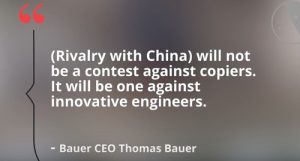
That’s a self-evident Chinese rationale inbuilt in BRI from the start – and Beijing never denied it. After all, the concept itself was first floated inside the Ministry of Commerce, way before the official announcements by President Xi Jinping in Astana and Jakarta in 2013.
Perceptions of the BRI vary across myriad latitudes. Central and Eastern Europe are mostly enthusiastic – as BRI is synonymous with badly needed infrastructure projects. So are Greece and Italy, as Asia Times reported. Northern ports such as Hamburg and Rotterdam are actually configured as BRI terminals. Spain is very much interested in the days when the Yiwu to Madrid cargo train will move to high-speed rail.
Essentially, it all boils down to companies from specific EU nations deciding their degree of integration with what Raymond Yeung, ANZ’s chief economist for greater China, describes as “the biggest economic experiment in modern history.”
Watch those Chinese engineers
The case of France is emblematic. President Emmanuel Macron – now on a massive geopolitical PR offensive to crown himself the unofficial King of Europe – actually praised the BRI when he visited China earlier this year.
But nuance, once again, applies: “After all, the ancient Silk Roads were never only Chinese,” Macron said in Xian at the Daming Palace, the residence of the Ancient Silk Road stalwart Tang dynasty for more than two centuries. “These roads”, added Macron, “cannot be those of a new hegemony, which would transform those that they cross into vassals.”
So Macron was already prepositioning himself to steer EU-China relations away and beyond the number one EU grievance: how the Chinese play the foreign trade/investment game.
Macron has been very vocal in prodding the European Commission bureaucracy to toughen anti-dumping rules against Chinese steel imports and forcing EU-wide screening of takeovers in strategic sectors, especially from China.
In parallel, virtually every EU nation – not only France – wants more access to the Chinese market. As much as Macron has touted an optimistic mantra – “Europe is back” – in terms of EU competitiveness, that barely masks the primordial European fear – the fact that it’s China that may be getting too competitive.
The BRI, for Beijing, is all about geopolitical but most of all geo-economic projection – including the promotion of new global standards and norms that may not be exactly those practiced by the EU. And that brings us to the heart of the matter, not enounced by the leaked internal report: the intersection between BRI and Made in China: 2025.
Beijing is aiming to become a global high-tech leader in less than seven years. Made in China: 2025 identified 10 sectors – including AI, robotics, aerospace, green cars and shipping and shipbuilding – as priorities.
China-Germany bilateral trade, at 187 billion euros last year, is way bigger than China-France and China-UK, at 70 billion euros each. And yes, Berlin is worried. Made in China: 2025 represents a significant “threat” to top quality German companies producing high-end manufacturing goods.
Those days may be over when China bought astonishing amounts of German machinery – plus the inevitable BMWs and Audis. The new normal points to an army of Chinese companies moving up the value-added chain at breakneck speed.
As Bauer CEO Thomas Bauer told Reuters: “(Rivalry with China) will not be a contest against copiers. It will be one against innovative engineers.”
Navigating the blue economy
The report Blue China; Navigating the Maritime Silk Road to Europe usefully expands the scope of the debate, pointing to how the development of the Maritime Silk Road may be even more crucial than overland connectivity corridors.
The report acknowledges how the Maritime Silk Road already affects the EU in terms of maritime trade and shipbuilding, and asks some questions about the increasing global presence of the PLA Navy. It recommends that the EU “should emulate China’s blue economy as an engine of growth and wealth, and encourage innovation to respond to well-funded Chinese industrial and R&D policies.”
The “blue economy” features heavily in Made in China: 2025 – especially in terms of innovation in port infrastructure and shipping. The rationale, from Beijing’s point of view, is always about maritime trade cost cutting – but that, of course, will always depend on whether oil prices will keep going up, as OPEC and Russia are keen.
As it stands, the EU bureaucracy has to be fearful, sensing the possibility of being squeezed between high-tech China and Trump’s America First. And that does not even factor in the inevitable geo-strategic clash between the BRI and the “free and open Indo-Pacific” to be managed, in theory, by the US, Japan, India and Australia; more of a glamorized South China Sea patrol than a vast project of Eurasian economic integration.
There will be an EU-China summit in July and then a Germany-China summit later in the year. Non-transparent sparks are bound to fly.
************
About the author
Featured image: Photo: AFP/Ludovic Marin
